The Radeon R9 280X Review: Feat. Asus & XFX - Meet The Radeon 200 Series
by Ryan Smith on October 8, 2013 12:01 AM ESTCompute
Jumping into compute, as with our synthetic benchmarks we aren’t expecting too much new here. Outside of DirectCompute GK104 is generally a poor compute GPU, which makes everything very easy for the Tahiti based 280X. At the same time compute is still a secondary function for these products, so while important the price cuts that go with the 280X are not quite as meaningful here.
As always we'll start with our DirectCompute game example, Civilization V, which uses DirectCompute to decompress textures on the fly. Civ V includes a sub-benchmark that exclusively tests the speed of their texture decompression algorithm by repeatedly decompressing the textures required for one of the game’s leader scenes. While DirectCompute is used in many games, this is one of the only games with a benchmark that can isolate the use of DirectCompute and its resulting performance.
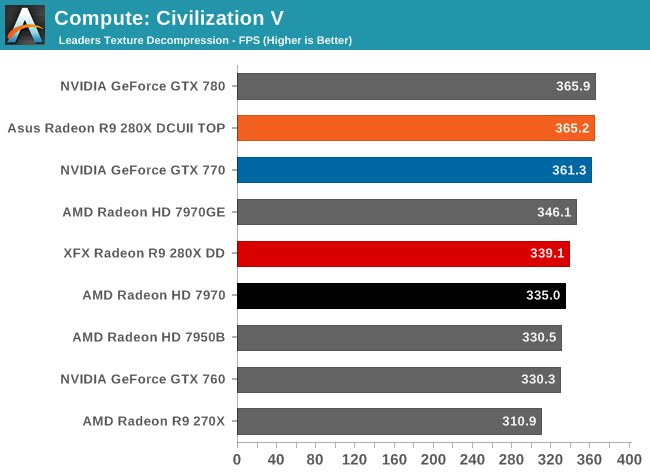
With Civilization V we’re finding that virtually every high-end GPU is running into the same bottleneck. We’ve reached the point where even GPU texture compression is CPU-bound.
Our next benchmark is LuxMark2.0, the official benchmark of SmallLuxGPU 2.0. SmallLuxGPU is an OpenCL accelerated ray tracer that is part of the larger LuxRender suite. Ray tracing has become a stronghold for GPUs in recent years as ray tracing maps well to GPU pipelines, allowing artists to render scenes much more quickly than with CPUs alone.
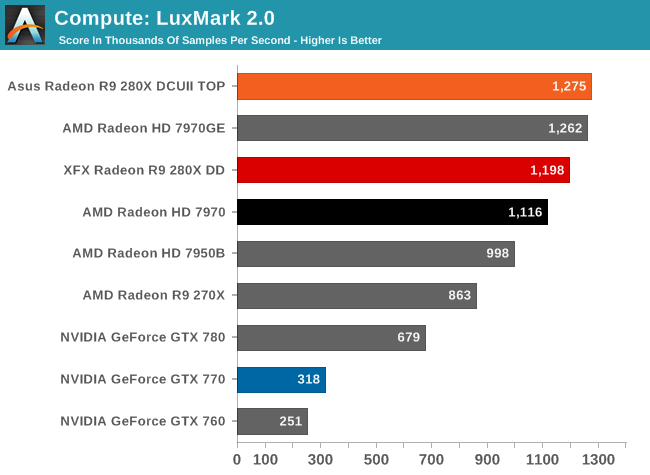
AMD simply rules the roost when it comes to LuxMark, so the only thing close to 280X here are other Tahiti parts.
Our 3rd compute benchmark is Sony Vegas Pro 12, an OpenGL and OpenCL video editing and authoring package. Vegas can use GPUs in a few different ways, the primary uses being to accelerate the video effects and compositing process itself, and in the video encoding step. With video encoding being increasingly offloaded to dedicated DSPs these days we’re focusing on the editing and compositing process, rendering to a low CPU overhead format (XDCAM EX). This specific test comes from Sony, and measures how long it takes to render a video.
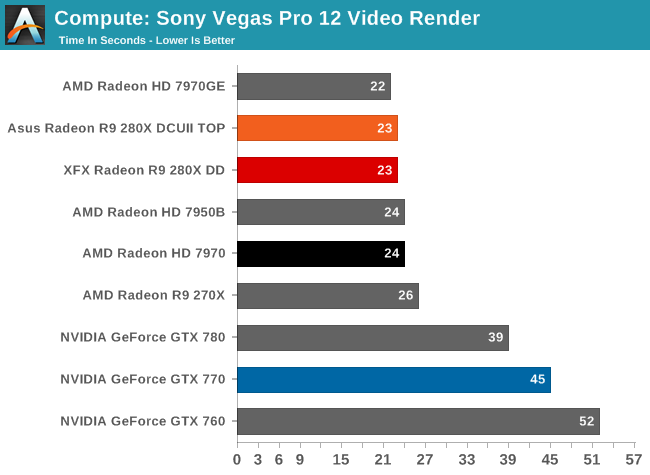
Again AMD’s strong compute performance shines through, with 280X easily topping the chart.
Our 4th benchmark set comes from CLBenchmark 1.1. CLBenchmark contains a number of subtests; we’re focusing on the most practical of them, the computer vision test and the fluid simulation test. The former being a useful proxy for computer imaging tasks where systems are required to parse images and identify features (e.g. humans), while fluid simulations are common in professional graphics work and games alike.
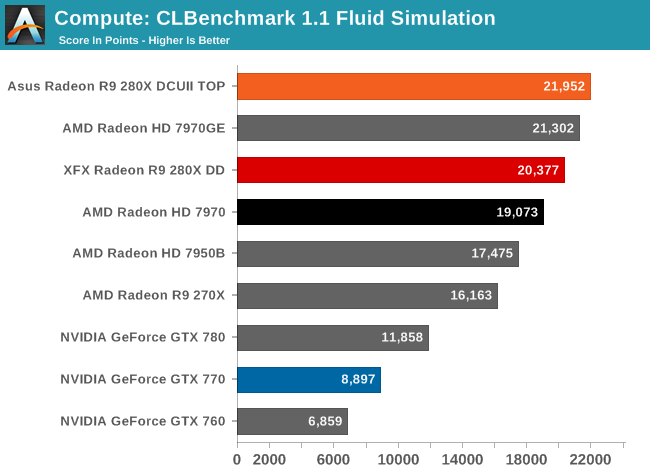
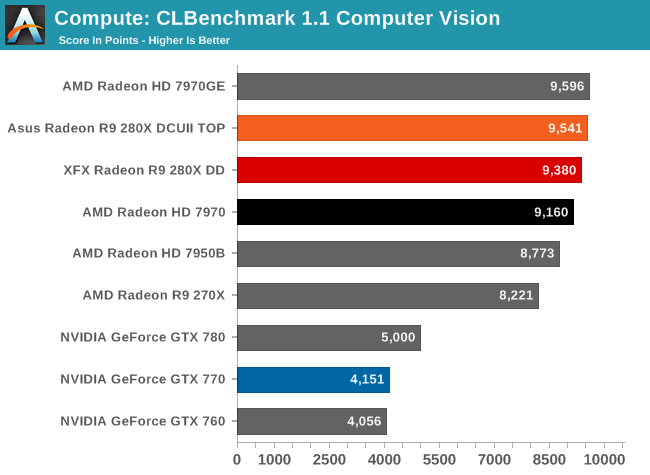
Despite the significant differences in these two workloads, in both cases 280X comes out easily on top.
Moving on, our 5th compute benchmark is FAHBench, the official Folding @ Home benchmark. Folding @ Home is the popular Stanford-backed research and distributed computing initiative that has work distributed to millions of volunteer computers over the internet, each of which is responsible for a tiny slice of a protein folding simulation. FAHBench can test both single precision and double precision floating point performance, with single precision being the most useful metric for most consumer cards due to their low double precision performance. Each precision has two modes, explicit and implicit, the difference being whether water atoms are included in the simulation, which adds quite a bit of work and overhead. This is another OpenCL test, as Folding @ Home has moved exclusively to OpenCL this year with FAHCore 17.

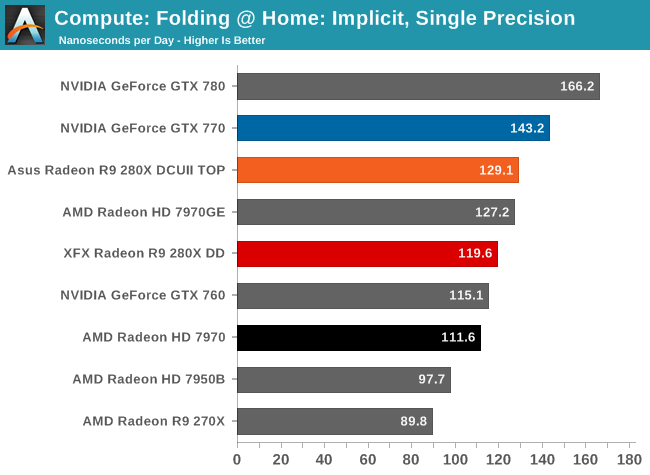

Depending on the mode and the precision, we can have wildly different results. The 280X does well in FP32 explicit, for example, but in implicit mode the 280X is now caught between the GTX 770 and GTX 760. But if we move to double precision then AMD’s native ¼ FP64 execution speed gives them a significant advantage here.
Wrapping things up, our final compute benchmark is an in-house project developed by our very own Dr. Ian Cutress. SystemCompute is our first C++ AMP benchmark, utilizing Microsoft’s simple C++ extensions to allow the easy use of GPU computing in C++ programs. SystemCompute in turn is a collection of benchmarks for several different fundamental compute algorithms, as described in this previous article, with the final score represented in points. DirectCompute is the compute backend for C++ AMP on Windows, so this forms our other DirectCompute test.
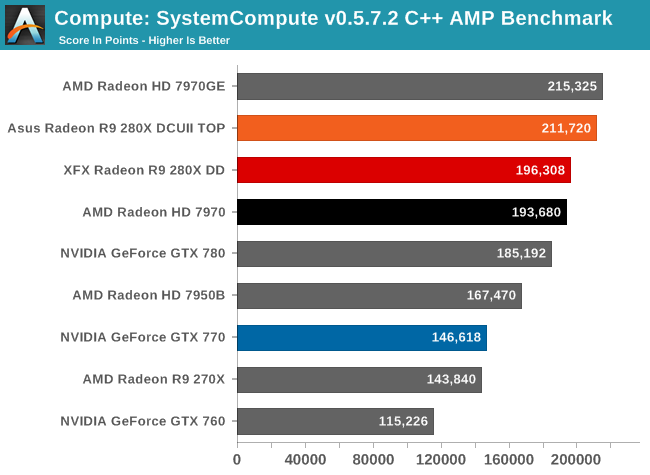
Although not by any means a blowout, yet again the 280X vies for the top here. When it comes to compute, the Tahiti based 280X is generally unopposed by anything in its price range.










151 Comments
View All Comments
HisDivineOrder - Wednesday, October 9, 2013 - link
Well, they did it for the Geforce 7xx series, so they probably had to do it for the new Radeons. That said, it's nice for users to see how little things changed. You know, for the people who didn't pay attention.I agree though it's kinda boring that we're gonna be stuck on the same Radeon series for another 6 months or year. At least nVidia seems vaguely on track with Maxwell, though unless something changes dramatically I think AMD is going to be putting 0 pressure on nVidia to release Maxwell.
Mantle could put pressure if they manage to get it into the gaming engines like they want. If so, they could force nVidia to 1) release their own API (and pay to be put in the same engines) or 2) put out better and better hardware to stay in the high level API with better performance.
Or they could do option 3) and do both.
IUU - Thursday, October 17, 2013 - link
"These aren't new cards. They are basically the same GPU's AMD has been shipping for almost 2 years now and it looks like they are going to try and pass them off again for another year. Why was this treated as some big new thing with a long article and a bunch of benchmarks? This whole thing could have been done in a little 2 paragraph news blurb."Of course they are not new cards. I feel your frustration, but why would they be new?
They render crysis at 43 frames per second at a freaking 2560x1440 resolution, not to mention battlefield and other games. There is simply " no need" for new hardware because there are not p new games to justify stronger hardware. A stagnation in gaming industry would more appropriately describe the situation.
Not that there is nothing to add to improve visual quality of the games, they just won't do anything about it, at keast for now.
jasonelmore - Tuesday, October 8, 2013 - link
disappointing to say the least. People were thinking this would perform at 780 levels are going to be dissapointed. i feel sorry for those that pre-ordered last week for $650+EzioAs - Tuesday, October 8, 2013 - link
This is the 280X not the 290X....jasonelmore - Tuesday, October 8, 2013 - link
ahh ok, i wouldnt have even bothered with this detailed of a review on rebadges with new firmware.EzioAs - Tuesday, October 8, 2013 - link
We don't need you to bother anything when you don't even read the title much less the review itself.RyuDeshi - Tuesday, October 8, 2013 - link
Well seeing as you didn't even bother reading the first page I can see that.It's still worth reviewing so that when people are trying to compare current GPUs, they have updated benchmarks with newer firmware to support those purchase decisions. This goes for both the AMD and Nvidia cards. The worst part about looking up old reviews of say the 7970 (which this is a rebadge of) is that most of them are with older firmware, and AMD had a pretty nice boost a few months after their release which this review more accurately reflects.
jasonelmore - Tuesday, October 8, 2013 - link
well i tried to edit my post literally 10 seconds after i posted but nope, looks like were still browsing 1999 websites that dont let you edit or delete your comments. anyways, yes i should have read the whole article to make any sort of comment at all. sorry.jasonelmore - Tuesday, October 8, 2013 - link
btw the 1st page wasnt up yet, only the charts were posted when i read. this is the problem with posting reviews before they are done, and stuff.Morawka - Tuesday, October 8, 2013 - link
yeah that was annoying